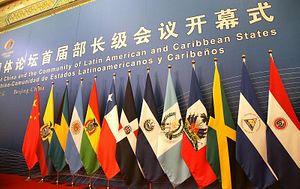In the light of the forthcoming visit of President Xi Jinping to the South American nations of Ecuador, Peru, and Chile, it’s timely to ask: how important is Latin America as a whole to China’s foreign policy agenda? Although trade ties between the two date back to the 1570s, bilateral relationships between China and regional countries remained considerably limited. Along with Beijing’s perception of the region as an integral part within the U.S. sphere of influence, factors such as geographical distance, cultural ignorance, and economic incompatibility had greatly restricted the relationship till the recent past.
Previously, Chinese scholars and foreign policy analysts were of the opinion that the Monroe Doctrine prevailed in the region. The Monroe Doctrine, articulated by U.S. President James Monroe in 1823, asserted U.S. hegemony over its southern neighborhood by telling other powers of the time to stay out. Quite unlike the past, however, in recent years China’s presence in the U.S. “backyard” has profoundly increased due to a number of factors.
First, China’s foreign policy has undergone a visible shift, from Deng Xiaoping’s dictum “lie low and bide your time” to a strategy of power projection and active engagement under President Xi Jinping. Although the region of Latin America is not strategically as important to China as South Asia or East Asia, bonhomie between the two sides has considerably increased in recent years along with China’s more active outreach.
Second, the ongoing Sino-U.S. power transition and America’s close engagement with allies in Asia as well as new partners such as India and Vietnam has in a way driven China into Latin America in order to counterbalance the United States.
Third, China seeks to fulfill its commercial interests. Latin America possesses a wealth of natural resources, which are crucial to China’s brisk economic development. China, for its part, seeks to obtain raw materials and diversify the source of such imports. In fact, the Chinese Ministry of Commerce has identified Latin America along with the Middle East/Africa and Russia/Central Asia as the three chief areas that are likely to become net energy suppliers for Beijing. Beijing also wants to sustain its access to overseas markets in order to secure the export of Chinese manufactured products. Bilateral trade between China and Latin America stood at $263.6 billion in 2014.
Fourth, China has significant geopolitical interests in the region. Although the Chinese government articulates its will to establish a cooperative relationship with the region, the White Paper on Latin America and the Caribbean published in 2008 clearly states that “the one China principle is the political basis for the establishment and development of relations between China and Latin America.” Currently, of Taiwan’s 22 diplomatic allies, 12 are found in Latin America and the Caribbean, more than in any other region.
Fifth, China adheres to the principle of multipolarity and the idea of multilateralism. To accomplish this objective, Beijing requires a network of allies from the Global South, including Latin American nations. In order to shore up the country’s bonhomie with the region, China has used the Global South or developing countries card. China claims that the country shares a common history with most developing nations, resulting in better understanding and shared demands and desires. Also, reinforcing solidarity on these grounds denotes that China combines patriotism with Marxist internationalism in its foreign policy.
Apart from bilateral commercial and political engagements, Beijing also engages with Latin American countries in various multilateral platforms such as the China-Community of Latin American and Caribbean States (CELAC) Forum, United Nations, Organization of American States (OAS), G5 group (Brazil, China, India, Mexico, and South Africa), BRICS group (Brazil, Russia, India, China, and South Africa), and the BASIC group (Brazil, South Africa, India, and China). Further, the number of high-level bilateral visits evidently indicates the importance Latin America enjoys in China’s foreign policy agenda. Between 2000 and 2015, Chinese premiers and presidents visited the region as many as 31 times, with Brazil, Argentina, Chile, and Cuba figuring as the top destinations.
China’s rising bonhomie with Latin America has clearly altered the geopolitics of the region and tendered a strategic challenge to the United States. Above all, China’s inroads into the region have questioned the validity of the Monroe Doctrine there. Although there remains a significant question as to whether Sino-Latin American ties can be defined as a win-win relationship, the region will definitely emerge as a testing ground between China and the United States in the forthcoming years.
Shaheli Das is a Junior Fellow at Observer Research Foundation and a Doctoral candidate at the Center for East Asian Studies, Jawaharlal Nehru University.

































